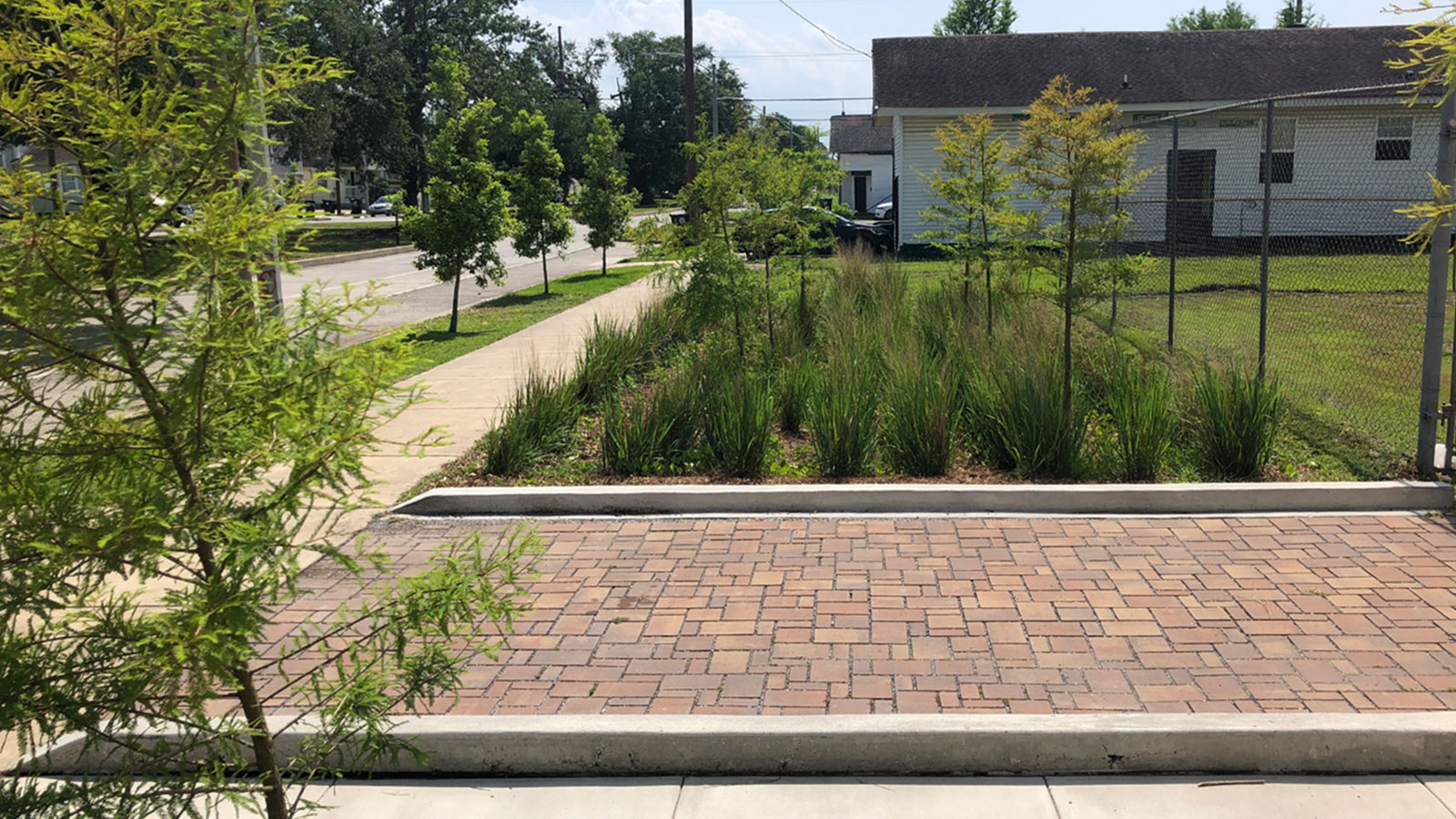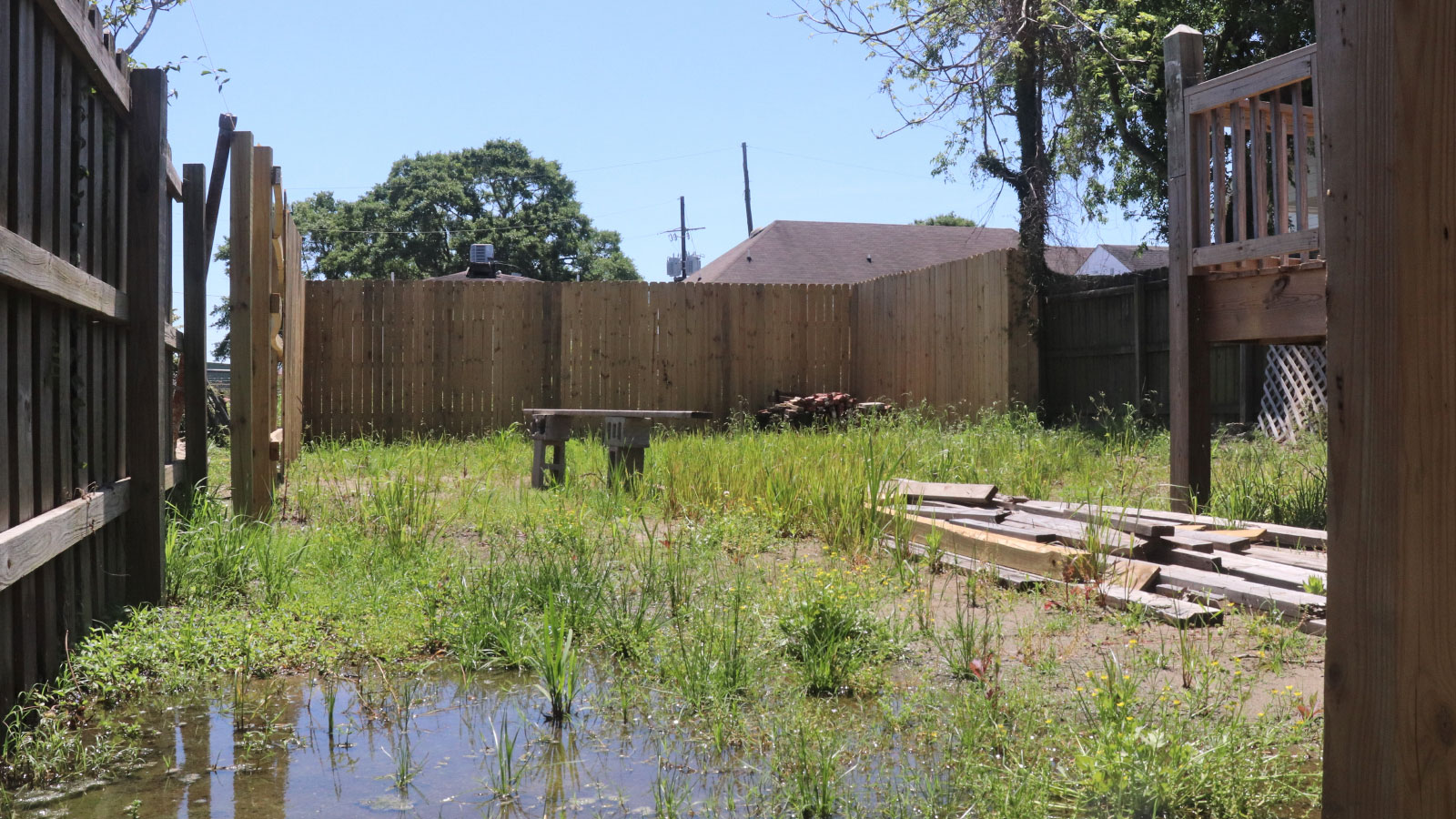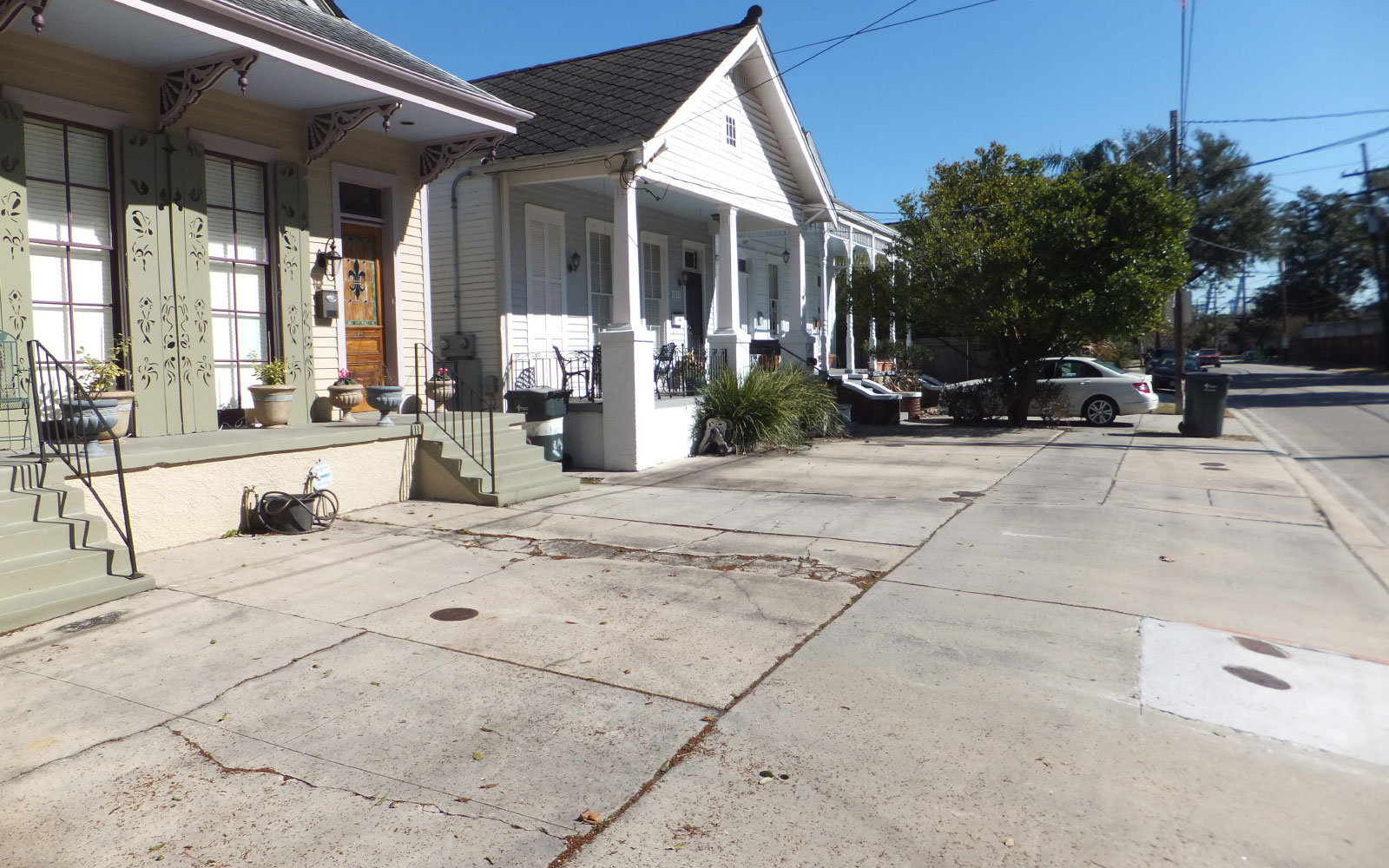This article is part of Ask Umbra’s guide on How to Build a Flood-Resilient Community.
When Hurricane Katrina hit New Orleans in 2005, the neighborhood of Hoffman Triangle was overwhelmed by 6 feet of water. But it doesn’t take a hurricane to make this wedge in the center of the city flood. The sidewalks, where they exist, are buckled, cracked, and overgrown from past deluges. Every time it rains, the narrow streets become rivers, the potholes tiny lakes. When the water comes — which it does, and will continue to — it makes navigating Hoffman by foot or by car feel like an obstacle course.
Dana Eness expertly navigates that gauntlet. The executive director of the Urban Conservancy, a New Orleans nonprofit that provides resources related to environmental stewardship, knows the neighborhood well. From her car, she can identify what material was used to make a particular parking lot, which homes have the best drainage systems, and which native plants, from muhly grass to sweetbay magnolias, would best serve the drainage or water management needs of each yard. She’s part of a grassroots coalition called Umbrella working to keep Hoffman relatively dry — no mean feat in a city that averages over 60 inches of rain a year — using landscaping interventions that can be implemented one yard at a time.
“You can do two things at once,” says Eness. “You can create space for water to go, and, if you’re thoughtful about it, you can create space within society for people who are being shut out economically.”
New Orleans is in the midst of a green infrastructure revolution, and in smaller neighborhoods like Hoffman Triangle, residents are leading the way, house by house, block by block. Along oak-lined South Galvez Street, Eness pulls over in front of Stronger Hope Baptist Church. It’s one of roughly 17 congregations in the neighborhood, which sits on less than a square mile. She points out a small rain garden the Umbrella coalition constructed to capture runoff from the church parking lot. Once, this was nothing more than ragged tufts of grass sprouting up from a broad swath of concrete. Now, there’s rich mulch with manicured rows of shrubs and clean, permeable pavement in the driveway. It’s been raining all week, and the new garden is soaked through, but the sidewalk and driveway are dry. The front yards of the homes across the road, meanwhile, are swamped with several inches of water.

For many New Orleanians, water management isn’t about billion-dollar levees or century-old pumps. It’s about small, nature-based projects like that rain garden or pavement that allows water to soak in, new wetlands, or streets lined with trees. These installations reduce the burden on the city’s aging, overwhelmed drainage system and can do a lot toward improving the quality of life for residents fed up with routine flooding.
But as the neighborhood of Hoffman Triangle has shown, flood resilience takes a village. Many of the Umbrella projects are constructed by landscaping firms owned and operated by New Orleans locals using this green revolution as an opportunity to bring in jobs and money. And by harnessing the power of the community, it can be done cheaply and effectively when time is running out for adaptation.

Year-round, New Orleanians deal with a chronic kind of inundation researchers vaguely call “urban flooding.” Overtaxed pipes back up, roadside ditches fill, and water pools, creating mosquito breeding grounds and blocking access to sidewalks and front steps. It eats away at foundations, damages cars, and allows mold and mildew to flourish.
For over a century, the city’s rapid, haphazard development created vast landscapes of pavement and concrete, which can’t effectively absorb water. Increasingly intense storms linked to climate change have brought one swift inundation after another. No longer able to soak into the ground, runoff from rainstorms flows into aging stormwater pipes, picking up all kinds of junk from fertilizer residue to miscellaneous litter along the way.
Much of New Orleans lies in a shallow bowl that dips below sea level, so to prevent flooding, every drop of water must be siphoned into Lake Pontchartrain through an elaborate system of canals and pumps. That leaves the underlying clay soils parched and brittle, unable to support the weight of the city’s infrastructure. As a result, New Orleans sinks a little lower every year. Meagan Williams, an engineer at the Department of Public Works, compares the soil under the city to a sponge: When it rains, the sponge expands; wring the water out, and it shrivels and hardens.
To compound the sponge problem, the city’s so-called “gray” infrastructure — the existing network of concrete pipes, pumps, and levees — isn’t always reliable. During floods in August 2017, several pumps failed. One investigation found that over 11,000 of the city’s catch basins were clogged by debris. Old-fashioned neglect has also created areas that Todd Reynolds, executive director of the nonprofit Groundwork New Orleans, calls “drainage deserts.” On South Johnson Street in Hoffman, for] example, there are four blocks without a single catch basin. “When it rains, every corner has two feet of water on it,” Reynolds says of these undeveloped stretches. “People shouldn’t have to live that way.”


One solution to all this flooding would be to rip up all the underground pipes and put in bigger ones to handle more water. But Reynolds says that’s a “trillion-dollar fix,” completely out of reach for any American city, let alone New Orleans.
Green infrastructure is a cheaper option to improve urban drainage. Some projects are as simple as the installation of a rain barrel that catches water flowing off a rooftop. Others transform entire “green” streets with planters, rain gardens, trees, and permeable pavement. They can be easier to build — simple enough for an individual homeowner to install — and, in the case of plant-based fixes, they can get stronger as greenery takes root and grows, rather than decaying with age.
The goal of “nature-based” solutions is to reduce the pressure on pipes and pumps by using landscaping to slow the flow of water. Projects can store water so it soaks into the soil or slowly flows into a storm drain at a rate the system can handle. Plants can also absorb water into their roots, leaching out pollutants in the process. They also come with various added benefits like improved water quality, mosquito control, and increased open space to cool the sweltering Louisiana air.
But even natural flood resilience measures can get expensive. Before green infrastructure projects can really take root, residents and city officials need to invest in undoing the damage that’s been done: namely, hacking away the existing concrete jungle.
The Urban Conservancy has carved out a niche for itself as the pavement removal experts. Its signature program, the Front Yard Initiative, provides technical assistance and partial reimbursement for DIY projects transforming patches of concrete into colorful native plant gardens, gravel trenches called French drains, trees, and porous pavement that can capture water.
Hoffman, though, has one of the lowest median incomes of any neighborhood in New Orleans, and many residents can’t afford a Front Yard project, even with partial reimbursement. So the Urban Conservancy partnered with a handful of groups, each with their own green infrastructure expertise, to form Umbrella, a neighborhood-wide program in the Triangle that provides pro bono residential installations.
The model is all about “small but meaningful actions.” At the home of Mr. Leroy on South Rocheblave Street, for example, water used to pool up to his back steps when it rained. The Umbrella coalition replaced 500 square feet of concrete with permeable paving and sod, allowing up to 1,000 gallons of water to slowly soak into the soil. Jesse and Ardean, other Hoffman homeowners, say they use water stored in their rain barrels for their gardens, helping plants and trees to thrive on their properties and saving money on their monthly water bill in the process.

“If every house does a little bit, we can make a huge impact,” said Arien Hall, a co-founder of the landscaping firm Mastondonte.
Mastondonte worked on another home on South Johnson Street owned by Leo Young, a longtime resident fondly referred to as “Coach” by his neighbors. Young had to deal with water pooling in the vacant lot next door, subsidence, and a sidewalk riddled with potholes and mud. The Umbrella coalition helped replace his home’s rusted gutters, fix pothole-riddled sidewalks leading up to his drive, and put in gravel trenches to help water soak into the ground and restore access to the sidewalk. But to truly fortify the neighborhood, properties can’t just be considered in isolation and Coach realized he needed to convince his neighbors to do the same. Since then, he’s become something of an ambassador for green infrastructure in Hoffman, talking about his project on the evening news and encouraging his neighbors to undertake similar work.
For all its climate benefits, New Orleans’ green infrastructure boom is as much about building a community and mutual aid as storing water. “We’re there to meet the felt needs of people,” says Chuck Morse, one of Umbrella’s founding members and a minister at a local Baptist church. “I believe that people don’t care how much you know, until they know that you care.”
The Umbrella coalition ended up in Hoffman largely because of Morse’s many connections in the neighborhood. In addition to his other roles, he’s also president of the neighborhood association and sits on the Equity Committee for the city’s Climate Action Plan. His personal breaking point with flooding came in 2018 when he almost missed his daughter’s graduation due to inundated streets after a storm. “That’s just truly not how it needs to be,” he says, shaking his head.
Morse’s role is to run a workforce development program to train young residents in green infrastructure construction and support locally-owned landscaping firms that can build these projects. He’s also connected Umbrella with faith-based communities in Hoffman. He frames water management in terms of his Christian notions of “stewardship” to get local ministers on board, and Umbrella has branched into larger green infrastructure projects on church property. While a homeowner can store maybe 1,000 gallons of water on a small lot, a church can store upwards of 20,000.
Kenneth Thompson, the pastor of Pleasant Zion Baptist a few blocks down from Coach, has said that the new trees and rain barrels on the church property are “a blessing to the neighborhood,” making community spaces more resilient in a way that will benefit more than just one building. That’s especially important because the majority of Hoffman residents are renters, meaning they have less power to modify their homes. To that end, the current homeownership crisis in the United States certainly illuminates some of the limitations of a property-focused approach to climate resilience — at some point, the city does have to step in.

In 2016, New Orleans secured over $140 million in funding through the federal government to develop a multi-faceted “resilience district” in one of the city’s largest neighborhoods. There’s $3 million for workforce development (which Morse’s Thrive is managing), a Community Adaptation Program that installs projects for homeowners, and over 8 miles of streets and canals that will be transformed into blue and green corridors of open space. At the same time, the city is undertaking its largest investment ever in roadwork, with $2.2 billion across 200 projects that include green infrastructure elements wherever possible.
It’s hard to compare the scale of grassroots effort to the city’s plans, or even what is needed overall to shore up New Orleans against the rising seas of the 21st century. Yet, everyone agrees that there’s a great need for the kind of house-by-house, neighborhood-level adaptation that Umbrella facilitates.

Colleen McHugh, a planner at the Water Institute of the Gulf, adds that grassroots efforts bring stability. Every time a new mayor comes on board, McHugh says, “you have a bunch of folks who started something, leave, and move on.” Community groups are more nimble, though, and keep momentum going through those transitions.
Williams, from the Department of Public Works, says that the city needs people working at every level to make green infrastructure work. Grassroots groups, she says, provide a “huge service” for individual residents. As the Stormwater Program Manager for the entire city, she adds that groups like Umbrella “shine a light on some of the boots-on-the-ground issues” like where it regularly floods, what’s working, and what’s not.
Of course, there are challenges. Projects on public property require permits that can be cumbersome to acquire. Todd Reynolds, from Groundwork, says it’s taken him years in some cases to get approval. The original design for Coach’s house on South Johnson Street, for example, originally envisioned putting permeable pavement in the right-of-way in front of his house, but the city blocked it because it interfered with its planned roadwork.
Then there’s the question of maintenance. Green infrastructure saves money down the line, but it can require more routine maintenance, such as nurturing seedlings as their roots take hold. On paper, it’s straightforward: The homeowner is responsible for upkeep, like keeping native plants alive, dumping out rain barrels, or clearing drains. But in a neighborhood like Hoffman with many older and fixed-income residents, that means carefully designing projects that owners will be able to manage physically and financially. Eness has taken to driving around with trash bags in her trunk to collect litter and keep projects clean.
Eness recently drove by a newly constructed home on Jackson Avenue where the Umbrella coalition had put in a permeable driveway to help direct water away from the structure. She hopes to see more projects like that in the future, where green infrastructure is incorporated into new constructions, to spare future residents the stress and cost of flood management. Without better long-term strategies and dedicated funding for maintenance, everyone agrees that no acres of rain gardens or miles of green corridors will solve the flooding problem.
There will also always be rainstorms that overwhelm the system, and green infrastructure alone won’t save the city from rising seas, intensifying storms, and sinking streets. As Hoffman resident Coach says: “The water got to go somewhere. You got to live with it.”


